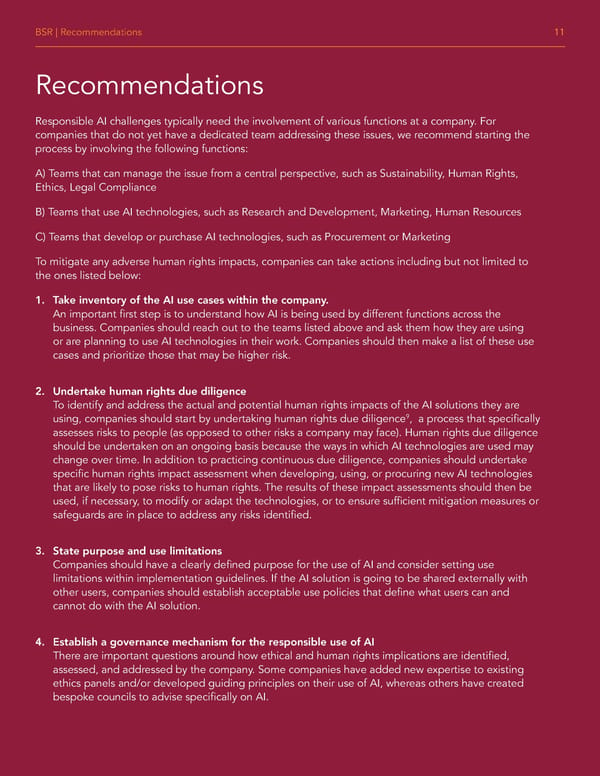BSR | Recommendations 11 Recommendations Responsible AI challenges typically need the involvement of various functions at a company. For companies that do not yet have a dedicated team addressing these issues, we recommend starting the process by involving the following functions: A) Teams that can manage the issue from a central perspective, such as Sustainability, Human Rights, Ethics, Legal Compliance B) Teams that use AI technologies, such as Research and Development, Marketing, Human Resources C) Teams that develop or purchase AI technologies, such as Procurement or Marketing To mitigate any adverse human rights impacts, companies can take actions including but not limited to the ones listed below: 1. Take inventory of the AI use cases within the company. An important 昀椀rst step is to understand how AI is being used by different functions across the business. Companies should reach out to the teams listed above and ask them how they are using or are planning to use AI technologies in their work. Companies should then make a list of these use cases and prioritize those that may be higher risk. 2. Undertake human rights due diligence To identify and address the actual and potential human rights impacts of the AI solutions they are 9, a process that speci昀椀cally using, companies should start by undertaking human rights due diligence assesses risks to people (as opposed to other risks a company may face). Human rights due diligence should be undertaken on an ongoing basis because the ways in which AI technologies are used may change over time. In addition to practicing continuous due diligence, companies should undertake speci昀椀c human rights impact assessment when developing, using, or procuring new AI technologies that are likely to pose risks to human rights. The results of these impact assessments should then be used, if necessary, to modify or adapt the technologies, or to ensure suf昀椀cient mitigation measures or safeguards are in place to address any risks identi昀椀ed. 3. State purpose and use limitations Companies should have a clearly de昀椀ned purpose for the use of AI and consider setting use limitations within implementation guidelines. If the AI solution is going to be shared externally with other users, companies should establish acceptable use policies that de昀椀ne what users can and cannot do with the AI solution. 4. Establish a governance mechanism for the responsible use of AI There are important questions around how ethical and human rights implications are identi昀椀ed, assessed, and addressed by the company. Some companies have added new expertise to existing ethics panels and/or developed guiding principles on their use of AI, whereas others have created bespoke councils to advise speci昀椀cally on AI.
 AI and Human Rights in Healthcare Page 12 Page 14
AI and Human Rights in Healthcare Page 12 Page 14